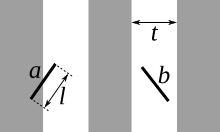
Back Agulla de Buffon Catalan Buffonova jehla Czech Buffonsches Nadelproblem German Aguja de Buffon Spanish Buffonen orratza Basque مسئله سوزن بوفون Persian Buffonin neula Finnish Aiguille de Buffon French המחט של בופון HE Ago di Buffon Italian

In probability theory, Buffon's needle problem is a question first posed in the 18th century by Georges-Louis Leclerc, Comte de Buffon:[1]
- Suppose we have a floor made of parallel strips of wood, each the same width, and we drop a needle onto the floor. What is the probability that the needle will lie across a line between two strips?
Buffon's needle was the earliest problem in geometric probability to be solved;[2] it can be solved using integral geometry. The solution for the sought probability p, in the case where the needle length l is not greater than the width t of the strips, is
This can be used to design a Monte Carlo method for approximating the number π, although that was not the original motivation for de Buffon's question.[3] The seemingly unusual appearance of π in this expression occurs because the underlying probability distribution function for the needle orientation is rotationally symmetric.
- ^ Histoire de l'Acad. Roy. des. Sciences (1733), 43–45; Histoire naturelle, générale et particulière Supplément 4 (1777), p. 46.
- ^ Seneta, Eugene; Parshall, Karen Hunger; Jongmans, François (2001). "Nineteenth-Century Developments in Geometric Probability: J. J. Sylvester, M. W. Crofton, J.-É. Barbier, and J. Bertrand". Archive for History of Exact Sciences. 55 (6): 501–524. doi:10.1007/s004070100038. ISSN 0003-9519. JSTOR 41134124. S2CID 124429237.
- ^ Behrends, Ehrhard. "Buffon: Hat er Stöckchen geworfen oder hat er nicht?" (PDF). Retrieved 14 March 2015.
